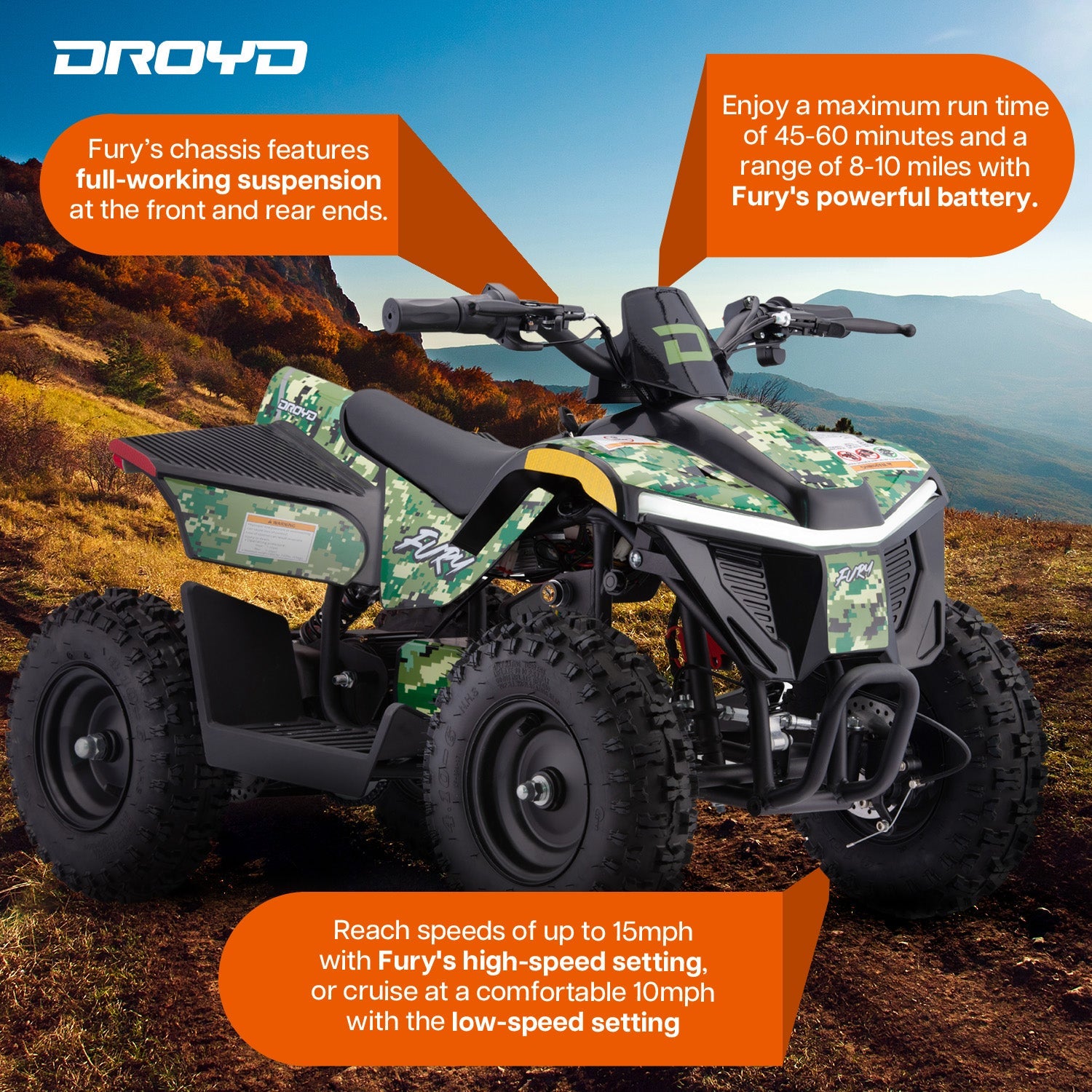Free Shipping on All Orders!

How Long Does an ATV Battery Last?
Posted on
An electric ATV depends on one thing above all — its battery. A strong, reliable battery provides consistent rides, while a weak one can cut fun short. So, how long does an ATV battery last? The answer depends on multiple factors, including battery type, riding style, and maintenance habits.
Understanding the differences between battery types and how they perform helps parents and riders make smarter decisions for both fun and safety, and it gives a clear picture of how long an ATV battery lasts in everyday use.
Understanding the Types of ATV Batteries
Electric ATVs typically run on one of three battery types: Flooded Lead Acid, Absorbed Glass Mat (AGM), or Lithium Iron Phosphate.
Flooded batteries are budget-friendly but require frequent upkeep. AGM batteries offer better durability with less maintenance, while lithium batteries last the longest and recharge quickly, though they come at a higher price.
Each option balances cost, care, and performance differently. Knowing these differences helps predict how long an ATV battery lasts under your riding conditions.
How Long Does an ATV Battery Last?
Flooded Lead Acid Battery
Flooded lead-acid batteries are the oldest and most basic type. They usually last about two to three years under average conditions. Proper care may stretch that to five years, though this is uncommon.
These batteries require topping off with distilled water and frequent checks. They discharge faster in storage, losing up to 13 percent of their charge per month, and they are heavier and more prone to leaking or corrosion.
While they may appear attractive for families on a budget, the added cost of early replacement and maintenance often offsets initial savings.
AGM Battery
AGM batteries are popular today, especially in quality youth electric vehicles. These sealed batteries do not need water or frequent monitoring, making them easier to manage.
On average, they last three to five years. With proper storage and charging, some may last up to eight years. AGM batteries hold a charge well, losing only 1 to 3 percent per month in storage, and resist vibration and cold weather.
They recharge faster than flooded batteries and perform reliably under load. A youth ATV like the Droyd Fury benefits from an AGM battery, combining performance with low-maintenance convenience.
Lithium Iron Phosphate Battery
Lithium batteries come with a higher upfront cost but offer superior performance and the longest lifespan among ATV battery types.
Many lithium batteries last eight to ten years or more, reducing the need for frequent replacements. They are fully sealed, lightweight, and highly resistant to heat and vibration. In storage, they lose only about 1 percent of their charge each month.
These batteries perform exceptionally well during extended periods of inactivity, such as summer or winter breaks. Cold temperatures can reduce their efficiency, so an AGM battery might sometimes be a better choice in very low climates. Lithium batteries provide steady power delivery and rapid recharge times.
For most riders, lithium batteries offer unmatched reliability, consistent energy output, and long-term value. Proper care and smart usage extend how long an ATV battery lasts and allow young riders to enjoy longer, more consistent rides without interruption.
How Riding Habits Impact Battery Life
Battery life is not only about chemistry; it is also about how the ATV is used. Frequent short rides, especially in high heat or cold, can shorten a battery’s lifespan. Starting and stopping often may not give the battery enough time to recharge fully during a ride.
On the other hand, riding at steady speeds and giving the ATV longer use intervals helps the battery last. Riding only once in a while. However, storing the ATV in a garage, is better than daily rides in extreme sun or freezing temperatures.
Even a high-quality youth electric ATV like the Fury will benefit from smarter riding habits. Many parents report better battery performance simply by avoiding overuse and keeping the ride indoors when not in use.
Charging Practices That Protect Your Battery
Poor charging habits can shorten battery life quickly. A common mistake is overcharging. Leaving a charger on too long may overheat the battery, cause swelling, or reduce its ability to hold a charge.
To charge correctly:
● Use a charger made for your battery type.
● Let the battery reach full charge before removing it.
● Avoid using car chargers or quick chargers that are not designed for smaller batteries.
Do not let the battery run completely flat.
AGM and lithium batteries prefer a steady charge. Some chargers come with smart sensors that turn off when charging is complete. These are good choices for families who want a “plug and forget” setup. For winter or off-season storage, trickle chargers can also help, though these are not recommended for lithium batteries.
External Factors That Shorten Battery Lifespan
Even the best battery can wear out early if the environment works against it. Extreme heat makes the liquid inside batteries evaporate faster. That leads to dry plates and lower power output. Corrosion becomes a bigger problem as well.
Freezing weather has the opposite effect. In cold conditions, batteries charge more slowly and deliver less energy. If an ATV is stored outdoors in freezing temperatures, the battery may suffer permanent loss in performance.
Flooded lead-acid batteries are the most affected by both temperature extremes. AGM batteries handle heat and cold better. Lithium batteries do well in heat but can underperform in freezing climates. For riders in colder regions, an AGM-powered youth ATV is often a better fit than a lithium-powered one.
Storing the ATV inside a garage or shed is a good way to reduce temperature damage. During the off-season, remove the battery and keep it charged in a cool, dry place. That simple habit can help a battery last one to two years longer.
Simple Practices That Add Years
A few small habits go a long way in keeping an ATV battery healthy.
· Keep Terminals Clean: Dirt or corrosion at the terminals weakens the connection and drains the battery faster. A quick brush and wipe every few months can fix this.
· Charge Before Storing: Do not store a battery while it is low. A fully charged battery stays stronger in storage.
· Avoid Full Discharges: Repeatedly letting a battery drain to zero can shorten its lifespan. Recharge when the level drops below 30 percent.
· Secure the Battery: Make sure the battery fits tightly and does not move around. Shaking can loosen connections and crack the case.
· Use the Right Charger: A charger that matches your battery type will help maintain a healthy charge cycle. Lithium batteries should not use trickle chargers.
New riders and parents often assume that ATVs need constant battery replacements. That is not true, especially for electric youth ATVs with smart maintenance features. In the Fury, for example, the battery design includes features that support steady charging and reduced wear, even with regular use.
Understanding Charging Cycles
Each battery has a lifespan measured in charging cycles. One cycle means a full discharge and a full recharge. Flooded batteries usually last 300 to 500 cycles. AGM batteries can go for 700 to 1,000. Lithium batteries top the chart with anywhere between 2,000 to 5,000 cycles.
Charging patterns affect this number. If you charge your battery when it is only half used instead of empty, it counts as a partial cycle. These smaller cycles are gentler and can extend the total number of usable charges.
That is why it helps to avoid draining the battery completely during every ride. Riders who plug in their battery at 40 or 50 percent often see longer lifespans compared to those who wait until the battery dies.
When to Replace Your ATV Battery
It is time to consider a new battery when the following signs appear:
● The ATV takes longer to start or does not hold a charge.
● You notice visible swelling or leaks near the battery case.
● Even after full charging, the ride time is much shorter.
● The battery loses charge during short periods of non-use.
These are signals that the battery can no longer store energy properly. Ignoring them can cause other issues, such as poor motor performance or overheating.
Replacing the battery before it fails completely is the safer and smarter choice. It reduces strain on the ATV’s electrical system and keeps riders from getting stranded mid-ride.
Powering the Next Ride — Safely and Smartly
Caring for your ATV battery is less about technical skill and more about steady habits. Know the type of battery your youth ATV uses. Match your charger, storage plan, and ride schedule to that type. Avoid deep drains. Keep terminals clean. Store it.
As parents and builders of kid-safe electric rideables, we design every Droyd product, especially the Fury, with those needs in mind. From smart battery design to secure compartments and simple charging systems, our youth ATVs support better battery care by default.
When your ATV battery performs well, your rider enjoys more time outdoors, and fewer stops along the way. That is what every good ride should feel like.




